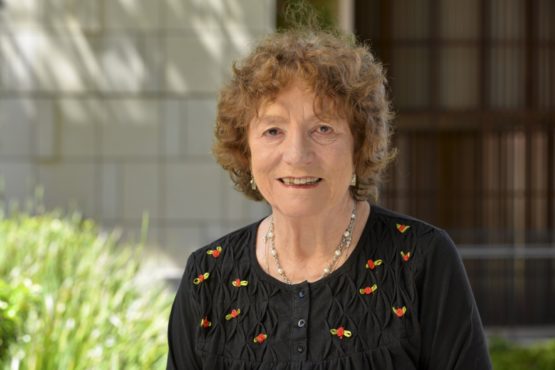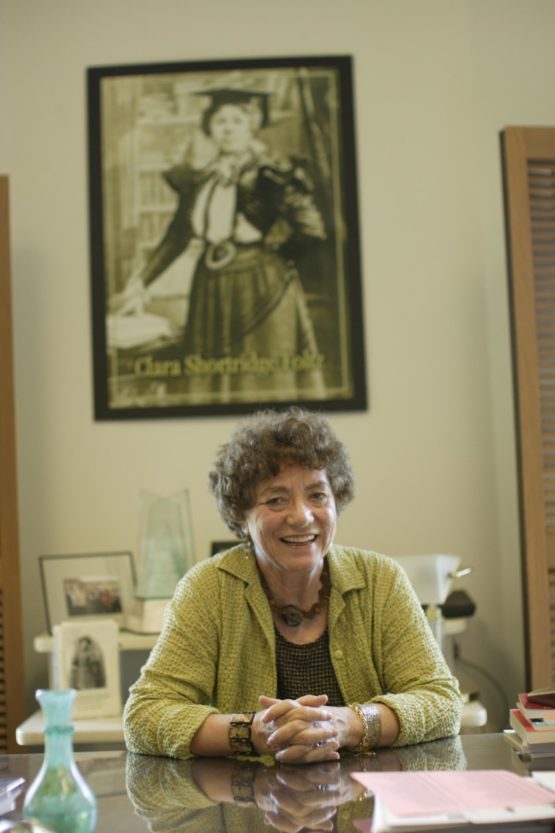Legal scholar Barbara Allen Babcock, the first woman member of the Stanford law faculty, has died at 81
Barbara Babcock was a pioneering attorney who was instrumental in the establishment of today’s Public Defender Service before becoming the first woman to serve on the faculty at Stanford Law School.
Legal trailblazer Barbara Allen Babcock, the first woman member of the Stanford University Law School faculty and the Judge John Crown Professor of Law, Emerita, died April 18 at age 81 at her Stanford home.

Barbara Babcock was an award-winning teacher and legal trailblazer who inspired the hundreds of students she taught. (Image credit: Rod Searcey)
Babcock had waged a long battle with cancer. Her husband of 41 years, Thomas Grey, the Nelson Bowman Sweitzer and Marie B. Sweitzer Professor of Law, Emeritus, was at her side.
Babcock joined the Stanford Law School in 1972. That was, however, not Babcock’s only professional first. In 1966, she joined a pilot project established by the District of Columbia to deliver legal defense services to the poor. In 1968, she was appointed the first director of D.C.’s newly named Public Defender Service. The success of the initiative gained national recognition and led to her recruitment to Stanford.
At Stanford, Babcock was an award-winning teacher and legal trailblazer who inspired the hundreds of students she taught.
“Barbara was not simply someone who left an enormously significant public mark, she was someone who was beloved by our students in a way most of us could only dream of,” said Jenny Martinez, the Richard E. Lang Professor of Law and dean of Stanford Law School.
“As dean, I get to talk to our alums frequently, and I can’t tell you how many mention Barbara as one of the most influential people in their lives,” Martinez said. “She was a model of personal warmth and grace, a fantastic storyteller, a true friend and mentor to hundreds of our students.”
Public defenders office
Babcock was a new attorney when she joined the pilot project that became the Public Defender Service. After graduating from Yale Law School, she clerked for Judge Henry Edgerton of the U.S. Court of Appeals for the District of Columbia Circuit and then became an associate at the criminal defense firm Williams & Connolly. But Babcock wanted to do legal aid work, so she joined the Legal Aid Agency in 1966.
Babcock recalled her experiences there in a 2016 interview with Stanford Lawyer after publication of her memoir, Fish Raincoats: A Woman Lawyer’s Life.
“Back then the director’s salary was set at $16,000,” she said. “You couldn’t raise a family on it. So they had a lot of difficulty finding applicants. There were a lot of people who wanted the job, but couldn’t afford to take it. In the end, I just decided I would go for it, and I applied to be the director. I thought that I should. That it was a duty. And I became director in 1968. Then it turned into a huge prestigious job that made my career, but at the time it felt somewhat like a sacrifice, but one that I had to do – so I did.”
Babcock was credited with creating an agency that strove to give the same level of service to indigent defendants as that provided by private law firms. She established policies, including having every client represented by an individual attorney rather than the office as a whole, allowing attorneys to take cases only if they had adequate time to provide complete representation. Social workers worked with attorneys on sentencing, especially in juvenile court.
“Because of her leadership, a position at PDS became one of the most sought-after jobs in the country. It was filled with former Supreme Court clerks,” said Michael Wald, the Jackson Eli Reynolds Professor of Law, Emeritus, at Stanford. Wald worked with Babcock in 1971 during a sabbatical from Stanford Law, describing the experience as “an amazing education.”
Coming to Stanford Law
While running Legal Services, Babcock was invited to teach a new class at Georgetown Law called Women and the Law – one of the first legal courses focused on women’s issues in the country.
“There was this surge of people, of women, in law school. … They were really different from my generation – all we tried to do was not be noticed and to assimilate. But they didn’t. They said: ‘What is this? You got us here and nobody pays any attention to us and there are no women professors!’” Babcock recalled. She taught the same course at Yale before being considered for the Stanford Law faculty.
Tom Ehrlich, dean of Stanford Law from 1971 to 1976, recalls the turbulent atmosphere on campus and across the country in 1972, with protests against the Vietnam War and movements for equality and justice. The faculty was changing, and Babcock contributed to that change.
“It quickly became apparent to everyone that she was a terrific addition to the faculty,” he said. “She made it easier to hire more women on the faculty. And more faculty of color as well. She was a pathbreaker on many levels. She stands very tall in the history of Stanford Law School.”
Babcock was honored by the graduating class four times with the John Bingham Hurlbut Award for Excellence in Teaching. Her influence went beyond the classroom, and she became a role model. She was credited by former students for inspiring teaching on civil justice, racial equality, poverty and the importance of lawyers in society.
“Barbara Babcock changed my life for the better,” said retired Judge LaDoris Cordell, a Stanford Law graduate and retired judge of the Superior Court of California. “A terrific teacher, Barbara loved the law and adored her students, who, like me, adored her.”
Babcock also brought practical legal experience and a commitment to clinical education to Stanford. After taking a leave from Stanford from 1977 to 1979 to serve as assistant attorney general for the Civil Division in the U.S. Department of Justice, Babcock returned to help pilot the school’s first clinic. The student-initiated East Palo Alto Community Law Project was the precursor to today’s Stanford Community Law Clinic.
Clara Foltz biography
Babcock was author of the 2011 book Woman Lawyer: The Trials of Clara Foltz. Foltz was a late 19th- and early 20th-century lawyer, public intellectual, leader of the women’s movement, public defender and legal reformer. Her story was all but lost until Babcock made recovering it her life’s work.

Barbara Babcock with a poster-sized photo of lawyer Clara Foltz, a public defender and legal reformer whose story was all but lost until Babcock wrote a book about her. (Image credit: Courtesy Stanford Law School)
The book was widely praised, including by Justice Ruth Bader Ginsburg. Babcock spent years doing readings throughout the country.
“It’s hard today for both men and women to imagine what it was like in the days when there were few women lawyers, judges and law professors; and even harder to imagine what it was like to be one of those few women lawyers, judges and law professors. You had to be somebody very special. And if you had to pick one word to describe Barbara Babcock, that’s the word: special. A special lawyer, a special teacher, a special scholar,” says Lawrence Friedman, the Marion Rice Kirkwood Professor of Law at Stanford. “It was a labor of love for her to spend years writing the life of another special woman, Clara Foltz, and to restore Clara to her proper role in legal history. A century apart, two women pioneers.”
Foltz’s story was popular with readers, much as Babcock’s own would be with her memoir Fish Raincoats. One memory out of many that has resonated from the book was Babcock’s testimony at the Robert Bork U.S. Supreme Court nomination hearings in 1987. In that testimony, she criticized Bork as “a good 15 years behind the times on women’s rights.”
“Barbara’s memoir, Fish Raincoats, is filled with episodes from a spellbinding storyteller,” said Pamela Karlan, the Kenneth and Harle Montgomery Professor of Public Interest Law at Stanford.
“One of my favorites involves Barbara’s representation of a woman named Geraldine, who faced life in prison for a drug-possession offense. Barbara advanced a novel mental-illness defense: ‘inadequate personality.’ When the jury returned a verdict of ‘not guilty by reason of insanity,’ Geraldine burst into tears, threw her arms around Barbara, and exclaimed, ‘I’m so happy for you.’ Barbara used the story frequently to talk about both juries and the special vocation of the public defender. But the reason I always remember the story is because I have never known anyone with a more adequate personality than Barbara’s.”
Barbara Babcock was born in Washington, D.C, in 1938, and grew up in Hyattsville, Maryland, the daughter of Doris Moses Babcock and Henry Allen Babcock. Before graduating from Yale Law School, Babcock attend the University of Pennsylvania on a full scholarship, graduating Phi Beta Kappa.
She is survived by her husband, Thomas Grey; her stepdaughter, Rebecca Grey, and son-in-law, Christopher Luomanen; her granddaughter, Dinah Luomanen; two brothers, David Henry of Cranbury, New Jersey, and Joseph Starr, of Reno, Nevada. Her first husband, Addison Bowman, professor at the University of Hawaii law school, also survives her.
In lieu of flowers, the family suggests a gift in her name to Equal Rights Advocates, a woman-centered law firm she helped to found in the 1970s.
Read the full obituary in Stanford Lawyer.
